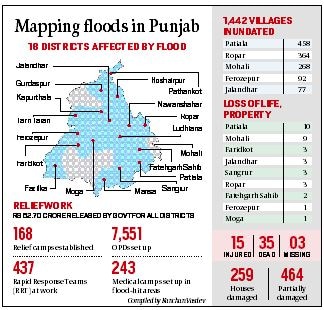Behind floods, rivers choked with gravel and sand — 15 times more than what Punjab needs
Little progress in river desilting despite multiple floods, says senior official.
 As water recedes after over a week, commuters move through still submerged road at village Mandi Cholian in Jalandhar, Monday. (Express photo by Anju Agnihotri Chaba)
As water recedes after over a week, commuters move through still submerged road at village Mandi Cholian in Jalandhar, Monday. (Express photo by Anju Agnihotri Chaba) Punjab, which is home to three major rivers — Sutlej, Beas, and Ravi — along with at least two seasonal ones — Ghaggar and Chakki — has experienced its worst floods this year in the last four years.
The 2019 floods, as per details, resulted in a loss of around Rs 1,200 crore to the state treasury. The damage this time, though not as severe as 2019, is expected to be significant as well, with the state still in the process of taking stock of its losses and many areas of Punjab, both urban and rural, continuing to remain submerged.
But as the water slowly recedes, authorities point out the one factor that has been common over the years which has been contributing to the state’s frequent flooding — the non-cleanliness of Punjab’s rivers.
A report submitted in 2020 by the Department of Mines and Geology, Government of Punjab, regarding the 2019 floods, states, “Rivers naturally carry silt, which has contributed to the formation of floodplains in Punjab. However, with the regulation of rivers, the deposition of silt is now limited to within the embankments. This has gradually reduced the water-carrying capacity of the rivers in the state over the years and is a significant factor behind the severity of the floods that occur every few years, causing immense physical and economic distress, particularly to farmers.”
The report further explains, “The drainage wing of the Water Resources Department estimates that the river beds have accumulated silt up to 5 to 12 feet. Additionally, the central 1/4th to 1/3rd width of the rivers contains over 7000 lakh MT (metric tonnes) of sand and gravel. Removing this sediment can increase the river’s capacity by 15,000 to 50,000 cusec, which is a significant improvement. The excavation would also prevent the river from meandering and causing damage to the embankments.”

The report notes that this quantity of sediment is at least 15 times the annual sand and gravel consumption of the state. The report also, however, goes on to highlight how due to other financial priorities, desilting of rivers has never been on priority.
The 2019 floods resulted in approximately Rs 200 crore worth of damage to the state water resources department’s infrastructure, in addition to a loss of around Rs. 1000 crore in crops and public properties. In a letter dated September 19, 2019 (number 3439-41/5F2019), the water resources department, Punjab, had stated that silting of river beds has been a major contributing factor to the floods and requested the mines and geology department to explore the possibility of removing excess river bed material, through mining contractors.
In 2020, the Cabinet approved the allocation of 78 sites in seven blocks to mining contractors, as proposed by the drainage wing of the water resources department. These sites encompassed a total area of 651.02 hectares, with 274.22 LMT (lakh metric tonnes) of sand/gravel.
Sources, however, claimed that in the years that followed 2019, very little was actually done on the ground in removal of sand/gravel from the river beds. A senior officer in the drainage wing of the water resources department of Punjab revealed that very little progress has been made in terms of river desilting, with several feet of silt mounds still being observed in the rivers.
Experts in drainage department have stated that desilting needs to be conducted systematically, limited to the natural river bed level, starting from the middle of the river to create a channel. The excavation process should be supervised by the drainage wing, which possesses the necessary technical expertise.
“In Punjab, no government has demonstrated a serious commitment to desilt rivers. Simply removing a few hundred lakh metric tonnes of sand and gravel from the river will serve no purpose when there is already 7000 lakh metric tonnes of sediment present, and the accumulation continues each year,” stated an official of the drainage department on condition of anonymity. They added that if the amount spent on compensating flood damages were invested in desilting and related flood control measures, floods would no longer wreak havoc.
In Punjab, the Sutlej River flows for 416 km with a width of 1,500 meters. Its water-carrying capacity is between 200,000 and 300,000 cusecs. However, due to silting, the river’s capacity has been reduced to 80,000 to 90,000 cusecs at several locations, resulting in floods.
Of the other major rivers, the Beas flows for 136 km and has a width of 1,000 meters and a water-carrying capacity of 200,000 to 300,000 cusecs. The Ravi, which flows for 222 km with a width of 500 meters, has a water-carrying capacity of 60,000 to 100,000 cusec; the Ghaggar, stretches for 165 km and has a width of 150 meters and a water-carrying capacity of 31,500 to 42,000 cusecs; and the Chakki, spans for 35 km, has a width of 125 meters and a water-carrying capacity of 50,000 cusecs.
Officials state that they cannot proceed with implementing solutions without the government’s approval, as policies need to be formulated based on their reports. Gurmeet Singh Meet Hayer, the Minister for Water Resources, Mines, and Geology, was not available for a comment on the issue.
Contacted, AAP MP, Balbir Singh Seechewal, said, “There is an urgent need to address the issue of silt accumulation and encroachments in the rivers of our state if we want to safeguard our future generations. The rivers at present are heavily burdened with an immense amount of silt hampering their natural flow. This is resulting in disasters in the form of floods. Moreover, the encroachment of riverbanks and riverbeds by a few individuals has far-reaching consequences that affect thousands in the state.”







